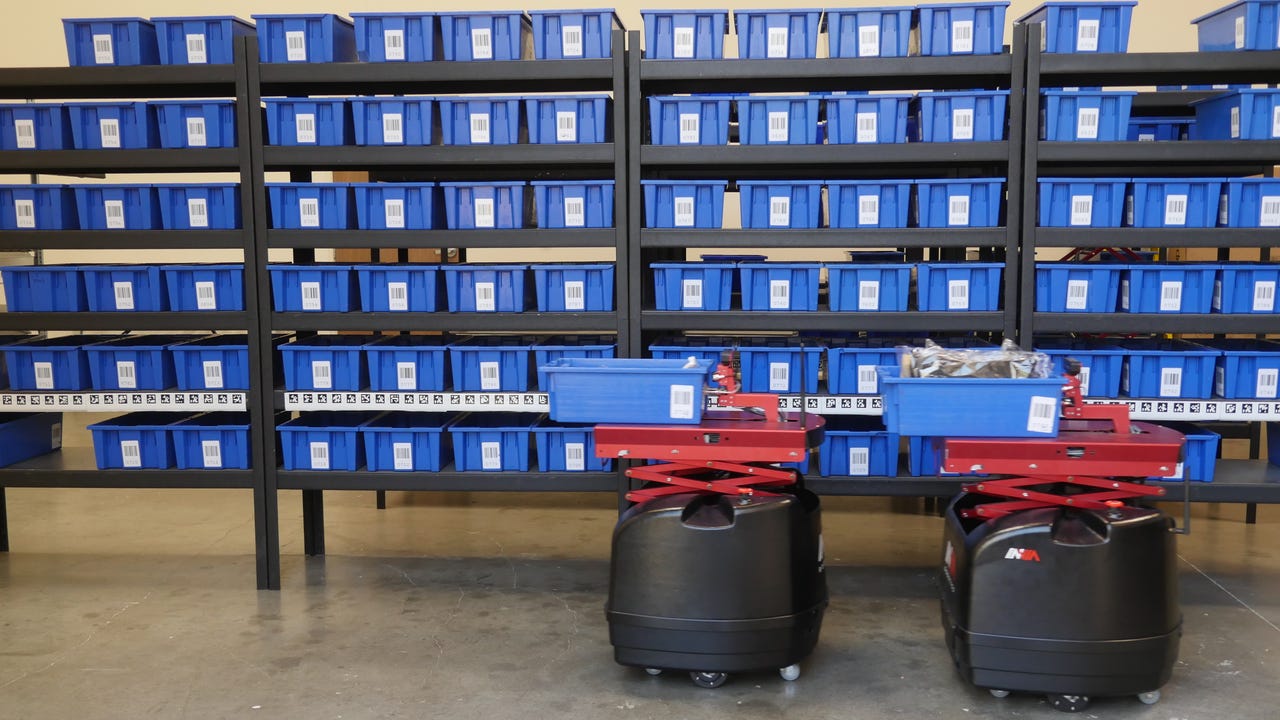Robots-as-a-service: New company introduces first 'goods-to-box' warehouse picking system


The rise of ecommerce has changed the way we shop, but many of the warehouses behind the products we buy haven't developed at the same pace. Today's consumers have come to expect instant gratification, and when they place an order online, they expect to get it quickly (otherwise, they'll just shop from a different website next time). Ecommerce companies need to get orders out the door at a pace that is faster than humanly possible.
Still, many facilities use the original man-to-goods model, where a person follows a pick list and moves from shelf to shelf, gathering the correct items for each order. Today's larger companies are increasingly adding more automation to their warehouses, such as Amazon's acquisition of Kiva's robotic picking system. Kiva and similar robots flip the model around, so that the goods are brought to the human workers by robots. Now, inVia Robotics is taking automation one step further with a mobile robotic system that places items directly into shipping boxes.
"What we've introduced, and we're the first with that, is goods-to-box," says Lior Elazary, inVia's CEO and founder. "And that means we're picking the items from the shelf and putting it right into a tote or the box that is going out for packing."
I spoke with Elazary, as well as COO Dan Parks, to find out why inVia's new system is different from existing options. Investments in robotics R&D are growing, and this has led to a surge in the number of related patents. InVia's founders met while they studied robotics at the University of Southern California, and they hold several patents related to the technology behind their picking system.
They had all worked on DARPA's robotics challenges, where they learned to create advanced vision algorithms to help perception, which robots need in order to navigate and grasp objects. "What we think is holding back robotics is not the hardware," says Parks. "We think it's the algorithms and the vision."
InVia's robots can be programmed to move quickly while they pick in human-free zones, and then they can slow down when they deliver the goods to people who pack the orders. If someone unexpectedly walks in a robot's path, sensors will detect them, and the robot will automatically stop. In this way, the robots work alongside humans to pick and ship products at a faster pace and a lower cost per pick.
According to Elazary, companies with no automation can spend as high as a dollar per pick. Adding automation such as conveyor belts dramatically reduces costs to 25 cents per pick, and inVia's goods-to-box solution rings in at just 10 cents per pick. "In the past, for you to be able to do this kind of automation you'd have to spend several millions of dollars," he says.
InVia reduced costs by choosing cheaper hardware, such as cameras, which they were able to compensate for with excellent perception. The system also requires a minimal investment because of a unique "robotics as a service" business model.
Instead of buying a fleet of robots, customers pay a monthly service fee based on the number of picks they need to accomplish. With this model, warehouse employees don't have to be experts in robotics; inVia's team handles the setup, maintenance, and any necessary repairs. Another perk of the service model is that during busy seasons or periods of growth, companies can easily add additional robots.
"It allows them to scale, allows them to plan, and it gives them also cost certainty," Elazary explains.
Invia Robotics/LD Products CaseStudy from inVia Robotics on Vimeo.
Unlike most mobile robots, inVia's robots don't require infrastructure changes such as embedding magnets into floors or changing shelving. At the most basic level, the robots can simply read orders and pick them, as long as products are in labeled boxes or bags. The robots can also be integrated with warehouse management systems (WMS) and enterprise resource planning (ERP) software to add additional capabilities, such as counting inventory and matching items against a company's database to ensure accuracy.
Robotics
The system can integrate with existing workflows, but companies will get more bang for their buck if they are willing to make a few adjustments to make their facilities more robot-friendly. Clothes, for example, are often still shipped with hang tags or even hangers -- display items that make sense if they were going to be sold in a store but serve no purpose when they are shipped directly to a customer. For ecommerce, items like hang tags hinder automation.
Simple changes can increase a warehouse's throughput. InVia's customer LD Products has added QR codes to their products and plans to make additional changes to create a better environment for robots. With some small changes, the robots will be more accurate and speedy.
Despite the fact that automation reduces labor costs, Elazary and Parks insist that automation doesn't steal jobs from humans. On the contrary, it can actually increase the total number of jobs because it allows smaller operations to compete with larger, established businesses. After adding inVia's picking system, LD Products was able to focus on quality control and strategic planning, and they are now expanding by adding a new fulfillment center. Elazary asserts:
What we're changing is we're changing the picker from sitting there and picking a certain number of items per day to managing a robot that can pick thousands of items per day. That results in a better job, better pay, and usually the employees themselves are happier.
Image: inVia Robotics